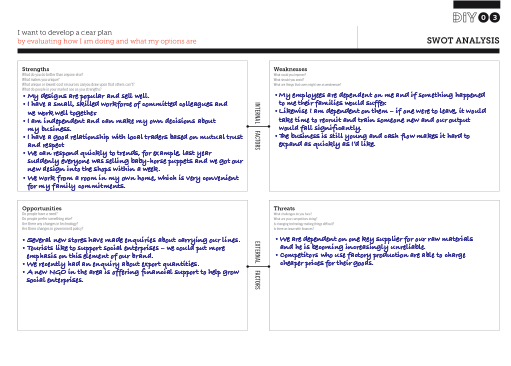5.1 SWOT analysis: a case study
Read through the case study and SWOT Analysis Template, then try to complete the activity below.
Case study 1: Syed’s business opportunity
Syed runs his own enterprise in an area on the outskirts of Dhaka, Bangladesh. He manages a collective of people with disabilities who make Bangladeshi puppets in a traditional style, mainly selling to tourists through local shops, and pays them a basic salary as well as a profit share. The puppets are all made to Syed’s own designs, and are quite different to the standard items in most tourist stores. His quirky designs and their popularity with shoppers have come to the attention of Muhammad, who runs a relatively large factory producing puppets and other tourist-friendly wares. Muhammad approaches Syed to suggest that he buy his enterprise, including his designs, and that Syed and his employees all come and work at Muhammad’s factory. He is offering a lot of money, and Syed doesn’t know whether he wants to maintain his independence or go for the security offered by a lump cash sum and guaranteed employment. He uses a SWOT analysis to take a snapshot of his current situation and help him consider the decision:
Activity 4
Looking at the case study above, including Syed’s SWOT analysis, imagine you are helping Syed make his decision. What points would you highlight? Would you recommend him to sell to Muhammad? Make some notes in answer to this question in the text box below.
Discussion
Syed has provided some interesting information in his SWOT analysis. By taking a realistic look at his business as it is, he can decide what is most likely to make sense for its future. There’s no absolute right or wrong here (there rarely is in this sort of decision-making), but based on the information given I would advise Syed not to sell. These are the key points I would highlight:
- Syed has a lot of strengths, mainly based on the very fact that the organisation is small and under his management.
- Being dependent on one supplier is always a risk, especially now they are becoming unreliable. However, there’s no reason he couldn’t identify other suppliers and shop around to get a good deal and spread the risk by regularly using two or three.
- Syed has said that cash flow is a weakness that stops him from expanding. It sounds like now would be a great time to explore the financial support from the new NGO, as this would enable him to respond to some of the other opportunities (new shops and the potential for export) at his own pace and under his control.
- If he expands, perhaps he could take on some new employees part time? If he has, say, four employees who work half time rather than two who work full time, he has spread the risk of his dependency – if someone is ill or leaves, one or more of the others might be able to increase their hours.
- If he agrees to Muhammad’s offer, he will lose his independence and have to commute to a different workplace. Will the people he works with be able to commute, or in practical terms will this mean they become unemployed (and how might he feel about that)? More people will see and buy his designs, but will his name or mark be on them?
- What if he explores the opportunities for expansion that the SWOT analysis has highlighted, and then considers whether the offer looks tempting?
Finally, I would perhaps suggest that this isn’t a yes or no decision, and there might be a way that Syed could maintain all his strengths but still work in partnership with Muhammad. He could create some designs especially for Muhammad’s factory, and/or draw on some of his resources in exchange for design expertise. At this point, a SWOT analysis of the potential partnership could be a useful decision-making tool.
5 Using the SWOT analysis for decision making

